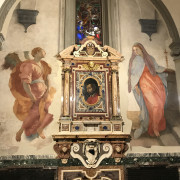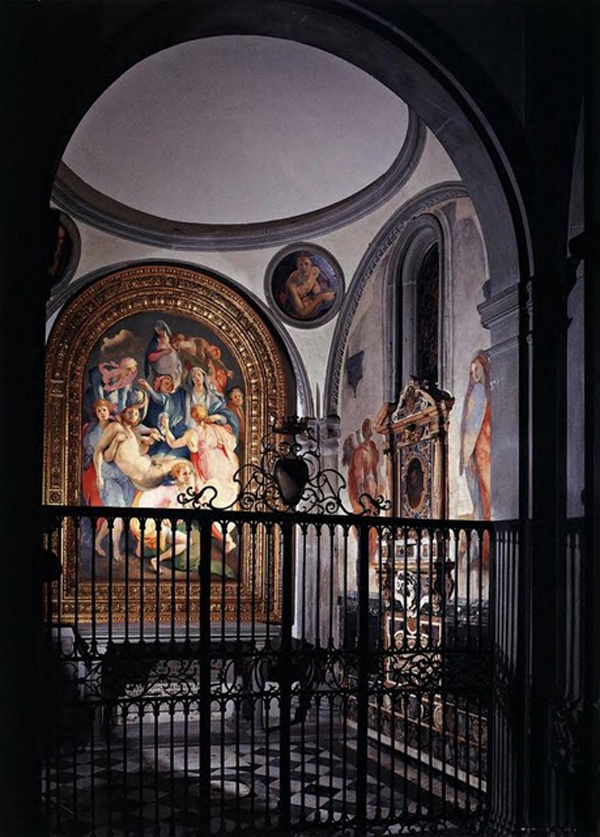CAPPELLA CAPPONI RESTORATION PROJECT
BY FRIENDS OF FLORENCE
IN THE CHURCH OF SANTA FELICITA IN FLORENCE PONTORMO:
DEPOSITION PAINTING
ANNUNCIATION FRESCO
AND ENTIRE CHAPEL WITH THE OTHER ARTWORKS
RESTORER: DANIELE ROSSI
As 2016 drew to a close, the return of Agnolo Bronzino’s St. Matthew tondo to its place in the squinch beneath the dome of the Capponi Chapel in the church of St. Felicita provided us with an opportunity to conduct a close inspection of the condition of the monument as a whole. An examination of the works of art in the chapel, and of the two frescoes making up the Annunciation in particular, highlighted a number of conservation issues. Most importantly, the supports of the two frescoes, detached in the 1960s, were clearly coming away from their wall supports and the brass screws supposed to be holding them fast to the wall were either missing or – which is even worse – visibly loose, thus diminishing the frescoes’ grip on the wall. Also, a lot of the retouching applied during restoration in the 1970s had totally deteriorated and the colours now clashed with Pontormo’s original palette.
The large panel painting depicting the Deposition from the Cross, when observed with sidelight on the altar, revealed a number of cracks in the upper right-hand area and there was evidence of the paint lifting in minute areas around the edges of the old wooden dowels.
The picture is still readable, but its readability is impaired and spoilt both by inconsistent oxidisation of the layers of varnish that have built up over the years and by excessive repainting in the course of previous restorations.
The original frame, carved by Baccio d’Agnolo, presented numerous woodworm holes, some of which had been plugged with wax, and the gold leaf was lifting in certain areas, while huge deposits of dust covering the entire carved surface had dulled the glitter of the gold.
Turning our attention to the 17th century Tabernacle of St. Charles Borromeo, certain pieces of the precious and semi-precious stonework (jasper and agate) were found to have either come away or to be clinging precariously to the extremely fine structure. In the centre of the tabernacle, St. Charles Borromeo’s face, painted in oil on semi-precious stone, was dulled by layers of oxidised varnish.
These conservation issues sparked the idea of finding a sponsor interested in a comprehensive restoration of the chapel in order to breathe new life into a monument whose unique beauty and importance as a milestone in the history of art has made it an object of worldwide renown.
A little history
The Capponi Chapel, which stands immediately on the right as you enter the Florentine church of Santa Felicita, was designed by Filippo Brunelleschi for the Barbadori family. The Capponi family took it over in 1525 and Lodovico Capponi commissioned Jacopo Carucci, known as ‘Pontormo’, to decorate it in 1526. The complex painted scheme comprised: the dome, mentioned by Vasari but unfortunately destroyed in the 18th century; the four Evangelists painted in tondos in the squinches beneath the dome, with the aid of a young Agnolo Bronzino; the Virgin Annunciate and the Announcing Angel (the Archangel Gabriel) frescoed on the inside wall of the church façade, on either side of the stained-glass window (a 20th century copy) and of a 17th century marble tabernacle with the effigy of St. Charles Borromeo; and a large panel painting on the altar, depicting the Deposition from the Cross. The original stained-glass window, now in the Palazzo Capponi alle Rovinate, was made in Arezzo by Guillaume de Marcillat, a French master glazier to whom Vasari was apprenticed as a young man.
 The Capponi Chapel in the church of Santa Felicita has been undergoing restoration since March of this year. The chapel’s enormous symbolic and artistic importance for the history of Italian art made it fairly simple for the Soprintendenza Archeologia Belle Arti e Paesaggio di Firenze to identify potential benefactors capable of grasping the urgency of a restoration dictated by its fragile condition. Simonetta Brandolini d’Adda, President of the not-for-profit Friends of Florence Foundation which has been involved for years in the conservation of this city’s art heritage, promptly pointed to Kathe and John Dyson as the generous individuals most likely to fund the restoration of this jewel of Florentine Renaissance art.
The Capponi Chapel in the church of Santa Felicita has been undergoing restoration since March of this year. The chapel’s enormous symbolic and artistic importance for the history of Italian art made it fairly simple for the Soprintendenza Archeologia Belle Arti e Paesaggio di Firenze to identify potential benefactors capable of grasping the urgency of a restoration dictated by its fragile condition. Simonetta Brandolini d’Adda, President of the not-for-profit Friends of Florence Foundation which has been involved for years in the conservation of this city’s art heritage, promptly pointed to Kathe and John Dyson as the generous individuals most likely to fund the restoration of this jewel of Florentine Renaissance art.
The chapel’s comprehensive restoration, which is still under way, is being conducted by Daniele Rossi and closely monitored by Daniele Rapino, a functionary with the Florence Soprintendenza.
The chapel’s condition, and the reasons for its restoration
Daniele Rapino told us: “The Capponi Chapel, the first on the right as you enter the church, was designed by Filippo Brunelleschi for the Barbadori family in around 1420. The Capponi family took it over in 1525 and dedicated it to the Pietà. Lodovico Capponi commissioned Jacopo Carucci known as ‘Pontormo’, one of the most innovative and original figures of the first half of the 16th century, to devise and produce the decorative scheme for the chapel in 1526. Vasari tells us that Pontormo took three years to complete the work, finishing the chapel in 1528 after barring everyone, including his patron, from peeking at what he was doing throughout that time”.
In the course of a recent inspection to monitor the chapel’s condition, the Soprintendenza official noted “the presence of a number of issues with the conservation of the works in the chapel.” “In particular,” he explained, “the two detached frescoes of the Virgin Annunciate and the Announcing Angel on the inside wall of the church façade were clearly coming away from their wall support and their brass screws were no longer fastening them to the wall. Also, a lot of the retouching applied in earlier restorations had totally deteriorated and the colours now clashed with Pontormo’s original palette. Several pieces of marble had come away from the 17th century reliquary tabernacle between the two figures making up the Annunciation and had either been stored elsewhere or were in a precarious condition. Also, a great deal of dust and soot had built up, hiding the fabulous moiré effect of the precious marbles and semi-precious stones (jasper and agate), while oxidised varnish had dulled the face of St. Charles Borromeo, painted in oil on a semi-precious stone base. A similar degree of deterioration could also be detected on the numerous commemorative plaques around the walls of the chapel, which we should remember the Capponi family had turned into a family mausoleum; and the wall surfaces themselves showed signs, in certain areas close to the ground, of the plaster coming away and of damage caused by damp; while a number of plaques had been moved around in the past, leaving clear marks and lacunas on the parts in pietra serena stone. Only the tondos with the four Evangelists were in good conditions because Daniele Rossi himself had restored them only recently.”
Rapino added: “On this occasion we also probed the inside of the dome, which was totally covered by a layer of neutral paint, and our investigation confirmed that the fresco that Pontormo painted on it was completely destroyed when the dome itself was lowered in the second half of the 18th century. On the other hand, we discovered that the trompe-l’œil architecture painted by Domenico Stagi in around 1780 is still there and we are currently considering whether or not to make it visible again.”
A painting by Pontormo depicting the Deposition from the Cross, on a poplar wood panel set in a gilded wooden frame masterfully carved by Baccio d’Agnolo, graces the chapel altar. Rapino told us: “This is an absolute masterpiece of Jacopo Pontormo’s art and one of the recognised milestones of early ‘Mannerism’, but it is also one of the paintings best loved and most intensely studied by scholars and visitors from all over the world. Known primarily for the expressionistic modernity with which this early 16th century painter managed to imbue the scene he was depicting, the painting today has a timeless quality to it, a sacred aura exuding poetry.”
On the lower right-hand side of the painting there is a crack in one of the panel joints which will be made good by inserting a polar wood micro-wedge in it. Seen in sidelight, the panel also presents a few cracks in the upper right-hand area, and there is evidence of the paint lifting in minute areas around the edges of the old wooden dowels. The picture is also spoilt both by inconsistent oxidisation of the varnish that has built up over the years and by excessive repainting in the course of previous restorations. The frame and panel are riddled with holes caused by woodworm, some of them still active, which were damaging the wood; also, some of the gold leaf is lifting, and there are massive deposits of dust on the entire carved surface dulling the glitter of the gold.
The two frescoes and the monumental gilded frame have been moved to the church’s north transept, which has been temporarily turned into a restoration laboratory, while the panel painting has been taken to Rossi’s workshop where it is undergoing restoration. Rossi is currently conducting chemical and stratigraphic analysis on the panel to determine the composition of the pigments and binding agents, as well as numerous diagnostic inspections which will probably reveal drawings and “second thoughts” beneath the original painted surface.
The Friends of Florence Foundation has earmarked 105,000 euro for the entire operation, including insurance and transport costs.
With the generous contribution of the Friends of Florence and, in particular, of Kathe and John Dyson, the restoration project was approved by the Soprintendenza Archeologia Belle Arti e Paesaggio per la Città Metropolitana di Firenze e le Province di Pistoia e Prato, and work got under way on 27 February this year.
Downloads:
